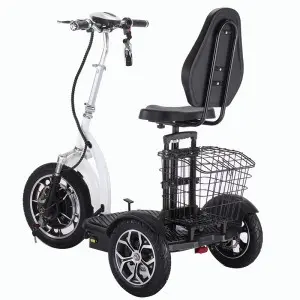How to ensure that the elderly three-wheeled scooter meets the ECE certification requirements
1. Overview of ECE certification
ECE certification, also known as E-Mark certification, is an approval system based on the technical quality standards (ECE Regulation) established by the Economic Commission for Europe (ECE). This certification applies to vehicles and their components, and is intended to ensure that these products meet Europe’s high standards for safety, environmental protection, and electromagnetic compatibility. For elderly three-wheeled scooters, ECE certification is a mandatory requirement for entering the ECE member states and the EU market.
2. The importance of ECE certification
Market access: Products that have obtained ECE certification can be freely sold and used in the markets of more than 50 member states of the ECE. This is a necessary condition for elderly three-wheeled scooters to enter the European market.
Consumer trust: ECE certification proves that the product meets strict safety and environmental standards, which helps to enhance consumer trust in the product.
Avoid legal risks: Products that fail to pass the certification may be detained by customs and even face penalties from market supervision agencies.
3. Specific requirements for ECE certification of elderly three-wheeled scooters
(I) Vehicle requirements
Safety performance:
Braking system: must comply with the requirements of ECE R13 to ensure reliable braking performance.
Collision safety: must meet the provisions of ECE R94 and ECE R95 to protect the safety of passengers in collisions.
Stability: The design and manufacture of the vehicle should ensure stability during driving and prevent rollover.
Environmental protection standards:
Emission requirements: If the vehicle is equipped with an internal combustion engine, it must comply with the emission standards of ECE R15 and ECE R49.
Noise limit: must meet the noise emission requirements of ECE R51.
Electrical system:
Electromagnetic compatibility: comply with the requirements of ECE R10 to ensure that the vehicle’s electrical system does not interfere with other equipment.
Electrical safety: must meet the provisions of ECE R100 to ensure the safety of the electrical system.
Other requirements:
Speed limit: must comply with the speed measurement and limitation requirements of ECE R68.
Lighting system: The lights must comply with relevant regulations such as ECE R19 and ECE R23.
(II) Component requirements
Lights: They must comply with regulations such as ECE R19 and ECE R23 to ensure that the brightness, illumination range and angle of the lights meet the requirements.
Rearview mirrors: They must pass the ECE R46 certification and meet the requirements of size, reflectivity, bending resistance and other requirements.
Tires: They must comply with regulations such as ECE R30 and ECE R54 to ensure the wear resistance, grip and safety of the tires.
Seat belts: They must meet the requirements of ECE R16 to ensure that the fixing points and restraint systems of the seat belts meet safety standards.
(III) Production consistency requirements
Manufacturers must ensure that each vehicle in the production process meets the standards at the time of certification. This includes:
Quality management system: The company must hold a valid ISO9001 or IATF16949 system certificate.
Regular audits: After obtaining the certificate, the company must undergo regular or irregular factory audits to ensure production consistency.
4. ECE Certification Process
(I) Preparation Phase
Understand the regulations: Enterprises need to have an in-depth understanding of the specific regulatory requirements for ECE certification of elderly tricycles.
Material preparation: Fill in the application form and prepare the relevant materials required for certification, including enterprise information, product information, technical parameters, CAD drawings, etc.
Choose a certification body: Choose a third-party agency with ECE certification qualifications for cooperation.
(II) Testing and evaluation
Sample testing: Send the elderly tricycle to a designated laboratory for various performance tests, including collision tests, braking performance tests, noise tests, electromagnetic compatibility tests, etc.
Factory audit: If the company is a manufacturer and does not have ISO9001 or IATF16949 system certificates, a factory audit is required.
(III) Report preparation and submission
Prepare the report: The certification body prepares a detailed certification report based on the test results, including product description, test data, evaluation conclusions, etc.
Submit for review: Submit the certification report to the relevant ECE agency for review.
(IV) Certification approval and registration
Approval: After the ECE agency passes the review, the ECE certification certificate will be issued.
Market registration: Enterprises need to register their products in various European countries to obtain market access permits.
发送反馈
Post time: Jul-21-2025



